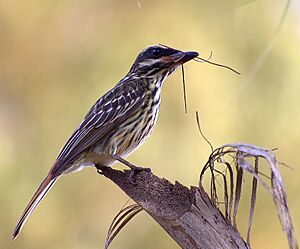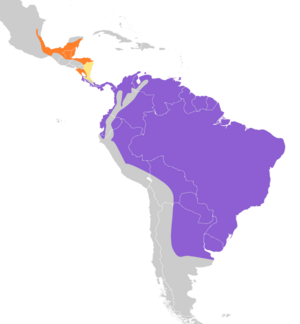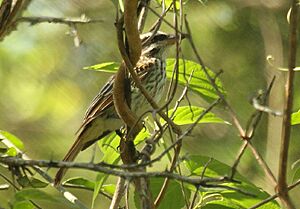Streaked flycatcher facts for kids
Quick facts for kids Streaked flycatcher |
|
|---|---|
 |
|
| In Sarutaiá (São Paulo state, Brazil) | |
| Conservation status | |
| Scientific classification | |
| Genus: |
Myiodynastes
|
| Species: |
maculatus
|
 |
|
The streaked flycatcher (scientific name: Myiodynastes maculatus) is a type of bird called a passerine. This means it's a perching bird. It belongs to the tyrant flycatcher family. These birds are known for catching insects while flying.
Contents
What Does the Streaked Flycatcher Look Like?
The streaked flycatcher is about 22 cm (8.7 in) long. It weighs around 43 g (1.5 oz). This bird has a strong, black beak.
Its head is brown with a hidden yellow patch on top. It has a white stripe above its eye, called a supercilium. A dark mask covers its eyes.
The top part of its body is brown. It has darker brown streaks on its back. Its wings have reddish-brown and white edges. The rump and tail have wide chestnut-colored edges. The underside of the bird is yellowish-white with brown streaks.
Male and female streaked flycatchers look very similar. However, young birds are brown where adults have black markings. One type of streaked flycatcher, M. m. solitarius, has black streaks instead of brown ones. This bird is easy to spot because it makes a loud sqEEE-zip sound.
It looks a lot like another bird, the sulphur-bellied flycatcher. But the streaked flycatcher has a bigger beak. Its belly is a lighter yellow. The bottom part of its lower beak is pink. Also, its stripe above the eye is creamy, not pure white.
Where Do Streaked Flycatchers Live?
These birds live and have their babies from eastern Mexico all the way south to Bolivia and Argentina. They are also found in Trinidad and Tobago.
Some streaked flycatchers, like the southern type M. m. solitarius, migrate. They fly to Venezuela and the Guianas during the austral winter. This happens from March to September.
You can find streaked flycatchers at the edges of forests. They also live in cocoa plantations. This bird is very common across its large home range. Experts do not think it is in danger of disappearing.
Streaked Flycatcher Behavior
How Streaked Flycatchers Find Food
Streaked flycatchers eat many different things. They mostly eat large insects. These include cicadas, locusts, and beetles. They also sometimes eat lizards and berries.
The bird sits on a high spot, like a tree branch. From there, it flies out quickly to catch insects. It can catch them in mid-air or off plants. It uses amazing flying moves to do this. Sometimes, it picks prey right off leaves.
When southern streaked flycatchers spend the winter away from home, they eat a lot of fruit. For example, they eat fruit from the Tamanqueiro tree. They often rip the fruit off while hovering in the air. Sometimes, they follow groups of different birds that are feeding together. They swoop down from trees to catch prey that other birds stir up from the ground.
Streaked Flycatcher Reproduction and Life Cycle
The streaked flycatcher builds a nest that looks like an open cup. It uses twigs and grasses. The nest is usually placed inside a tree hollow. Sometimes, it builds a nest in a bromeliad plant.
The female bird builds the nest. She lays two or three creamy-white eggs. These eggs have red-brown spots. She sits on the eggs for 16 to 17 days until they hatch. Both the male and female parents feed the baby birds. The young birds are ready to fly out of the nest in another 18 to 21 days.




